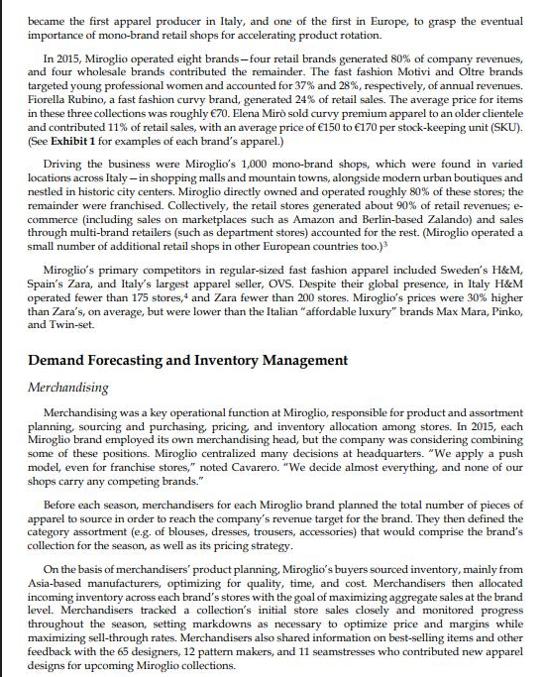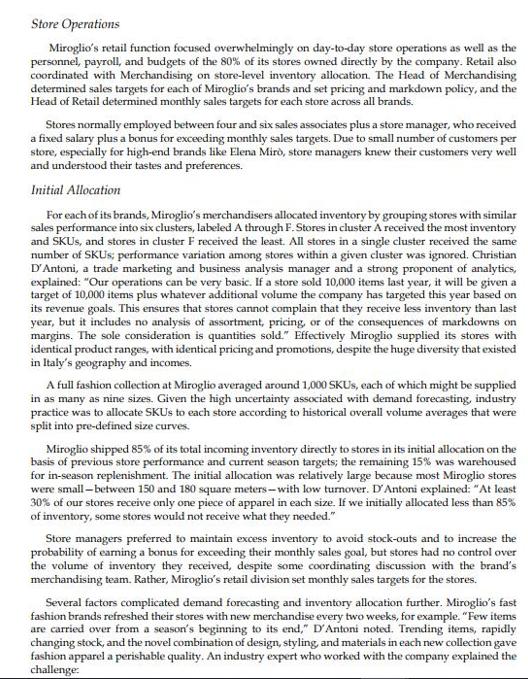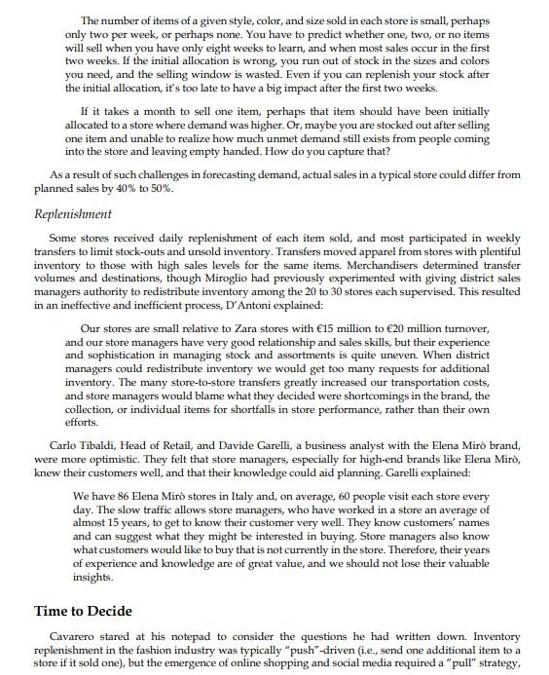Answered step by step
Verified Expert Solution
Question
1 Approved Answer
In late 2015, Francesco Cavarero, Chief Information Officer of Miroglio Fashion (Miroglio), Italy's third-largest retailer of women's apparel, with revenues of over 520 million,

In late 2015, Francesco Cavarero, Chief Information Officer of Miroglio Fashion (Miroglio), Italy's third-largest retailer of women's apparel, with revenues of over 520 million, was wondering how to bring analytical rigor to the company's planning and inventory management decisions. Demand forecasting and inventory allocation were inherently difficult in the fashion industry, and they were especially challenging for Miroglio because of the small number of units sold of each short-lived apparel item at each of its 1,000 stores. Miroglio's revenues and earnings had been declining in recent years and Cavarero was hoping that analytics could help the company reverse this trend. However, he faced many tough decisions as well as internal resistance. Many questions popped up in his head as he started writing them on his notepad - Was it even possible to build analytical models for slow-moving items? Was it better to do frequent inventory replenishment of items in each store, similar to industry leaders such as Zara, instead of trying to forecast demand? Should he rely solely on analytical models and ignore years of store managers' experience? Should he build this capability in-house or find a suitable partner? And how could he get internal buy-in, especially from the Head of Merchandising, who had been making these decisions for years? Miroglio Fashion In 1947, Giuseppe Miroglio installed the first modern weaving mills in Alba, a small town in northwest Italy, and began producing silk and synthetic textiles on an industrial basis. In 1955, he opened a second factory that applied U.S. mass production techniques to manufacture Italy's first women's apparel at scale. This offered Italians their first alternative to homemade or made-to-measure tailoring. The textile factory grew into Miroglio Textile, which eventually included textile printing and transfer paper businesses. The women's apparel factory became Miroglio Fashion. In 2015, Miroglio Fashion generated over 80% of Miroglio Group revenues. Founder Giuseppe Miroglio's grandson and namesake was president of the family-owned organization, overseeing about 5,500 workers in 34 countries. Miroglio Fashion boasted several firsts among Italian fashion firms. In 1985, the company launched Italy's first "curvy" (or plus-size) brand, Elena Mir. In 1993, Miroglio became Italy's first maker of fast fashion clothing, which it sold in dedicated shops under the Motivi brand. In doing so, Miroglio became the first apparel producer in Italy, and one of the first in Europe, to grasp the eventual importance of mono-brand retail shops for accelerating product rotation. In 2015, Miroglio operated eight brands-four retail brands generated 80% of company revenues, and four wholesale brands contributed the remainder. The fast fashion Motivi and Oltre brands targeted young professional women and accounted for 37% and 28%, respectively, of annual revenues. Fiorella Rubino, a fast fashion curvy brand, generated 24% of retail sales. The average price for items in these three collections was roughly 70. Elena Mir sold curvy premium apparel to an older clientele and contributed 11% of retail sales, with an average price of 150 to 170 per stock-keeping unit (SKU). (See Exhibit 1 for examples of each brand's apparel.) Driving the business were Miroglio's 1,000 mono-brand shops, which were found in varied. locations across Italy-in shopping malls and mountain towns, alongside modern urban boutiques and nestled in historic city centers. Miroglio directly owned and operated roughly 80% of these stores; the remainder were franchised. Collectively, the retail stores generated about 90% of retail revenues; e- commerce (including sales on marketplaces such as Amazon and Berlin-based Zalando) and sales through multi-brand retailers (such as department stores) accounted for the rest. (Miroglio operated a small number of additional retail shops in other European countries too.) Miroglio's primary competitors in regular-sized fast fashion apparel included Sweden's H&M, Spain's Zara, and Italy's largest apparel seller, OVS. Despite their global presence, in Italy H&M operated fewer than 175 stores, and Zara fewer than 200 stores. Miroglio's prices were 30% higher than Zara's, on average, but were lower than the Italian "affordable luxury" brands Max Mara, Pinko, and Twin-set. Demand Forecasting and Inventory Management Merchandising Merchandising was a key operational function at Miroglio, responsible for product and assortment planning, sourcing and purchasing, pricing, and inventory allocation among stores. In 2015, each Miroglio brand employed its own merchandising head, but the company was considering combining some of these positions. Miroglio centralized many decisions at headquarters. "We apply a push model, even for franchise stores," noted Cavarero. "We decide almost everything, and none of our shops carry any competing brands." Before each season, merchandisers for each Miroglio brand planned the total number of pieces of apparel to source in order to reach the company's revenue target for the brand. They then defined the category assortment (e.g. of blouses, dresses, trousers, accessories) that would comprise the brand's collection for the season, as well as its pricing strategy. On the basis of merchandisers' product planning, Miroglio's buyers sourced inventory, mainly from Asia-based manufacturers, optimizing for quality, time, and cost. Merchandisers then allocated incoming inventory across each brand's stores with the goal of maximizing aggregate sales at the brand level. Merchandisers tracked a collection's initial store sales closely and monitored progress throughout the season, setting markdowns as necessary to optimize price and margins while maximizing sell-through rates. Merchandisers also shared information on best-selling items and other feedback with the 65 designers, 12 pattern makers, and 11 seamstresses who contributed new apparel designs for upcoming Miroglio collections. Store Operations Miroglio's retail function focused overwhelmingly on day-to-day store operations as well as the personnel, payroll, and budgets of the 80% of its stores owned directly by the company. Retail also coordinated with Merchandising on store-level inventory allocation. The Head of Merchandising determined sales targets for each of Miroglio's brands and set pricing and markdown policy, and the Head of Retail determined monthly sales targets for each store across all brands. Stores normally employed between four and six sales associates plus a store manager, who received a fixed salary plus a bonus for exceeding monthly sales targets. Due to small number of customers per store, especially for high-end brands like Elena Mir, store managers knew their customers very well and understood their tastes and preferences. Initial Allocation For each of its brands, Miroglio's merchandisers allocated inventory by grouping stores with similar sales performance into six clusters, labeled A through F. Stores in cluster A received the most inventory and SKUs, and stores in cluster F received the least. All stores in a single cluster received the same number of SKUs; performance variation among stores within a given cluster was ignored. Christian D'Antoni, a trade marketing and business analysis manager and a strong proponent of analytics, explained: "Our operations can be very basic. If a store sold 10,000 items last year, it will be given a target of 10,000 items plus whatever additional volume the company has targeted this year based on its revenue goals. This ensures that stores cannot complain that they receive less inventory than last year, but it includes no analysis of assortment, pricing, or of the consequences of markdowns on margins. The sole consideration is quantities sold." Effectively Miroglio supplied its stores with identical product ranges, with identical pricing and promotions, despite the huge diversity that existed in Italy's geography and incomes. A full fashion collection at Miroglio averaged around 1,000 SKUs, each of which might be supplied in as many as nine sizes. Given the high uncertainty associated with demand forecasting, industry practice was to allocate SKUs to each store according to historical overall volume averages that were split into pre-defined size curves. Miroglio shipped 85% of its total incoming inventory directly to stores in its initial allocation on the basis of previous store performance and current season targets; the remaining 15% was warehoused for in-season replenishment. The initial allocation was relatively large because most Miroglio stores were small-between 150 and 180 square meters-with low turnover. D'Antoni explained: "At least 30% of our stores receive only one piece of apparel in each size. If we initially allocated less than 85% of inventory, some stores would not receive what they needed." Store managers preferred to maintain excess inventory to avoid stock-outs and to increase the probability of earning a bonus for exceeding their monthly sales goal, but stores had no control over the volume of inventory they received, despite some coordinating discussion with the brand's merchandising team. Rather, Miroglio's retail division set monthly sales targets for the stores. Several factors complicated demand forecasting and inventory allocation further. Miroglio's fast fashion brands refreshed their stores with new merchandise every two weeks, for example. "Few items are carried over from a season's beginning to its end," D'Antoni noted. Trending items, rapidly changing stock, and the novel combination of design, styling, and materials in each new collection gave fashion apparel a perishable quality. An industry expert who worked with the company explained the challenge: The number of items of a given style, color, and size sold in each store is small, perhaps only two per week, or perhaps none. You have to predict whether one, two, or no items will sell when you have only eight weeks to learn, and when most sales occur in the first two weeks. If the initial allocation is wrong, you run out of stock in the sizes and colors you need, and the selling window is wasted. Even if you can replenish your stock after the initial allocation, it's too late to have a big impact after the first two weeks. If it takes a month to sell one item, perhaps that item should have been initially allocated to a store where demand was higher. Or, maybe you are stocked out after selling one item and unable to realize how much unmet demand still exists from people coming into the store and leaving empty handed. How do you capture that? As a result of such challenges in forecasting demand, actual sales in a typical store could differ from planned sales by 40% to 50%. Replenishment Some stores received daily replenishment of each item sold, and most participated in weekly transfers to limit stock-outs and unsold inventory. Transfers moved apparel from stores with plentiful inventory to those with high sales levels for the same items. Merchandisers determined transfer volumes and destinations, though Miroglio had previously experimented with giving district sales managers authority to redistribute inventory among the 20 to 30 stores each supervised. This resulted in an ineffective and inefficient process, D'Antoni explained: Our stores are small relative to Zara stores with 15 million to 20 million turnover, and our store managers have very good relationship and sales skills, but their experience and sophistication in managing stock and assortments is quite uneven. When district managers could redistribute inventory we would get too many requests for additional inventory. The many store-to-store transfers greatly increased our transportation costs, and store managers would blame what they decided were shortcomings in the brand, the collection, or individual items for shortfalls in store performance, rather than their own efforts. Carlo Tibaldi, Head of Retail, and Davide Garelli, a business analyst with the Elena Mir brand, were more optimistic. They felt that store managers, especially for high-end brands like Elena Mir, knew their customers well, and that their knowledge could aid planning. Garelli explained: We have 86 Elena Mir stores in Italy and, on average, 60 people visit each store every day. The slow traffic allows store managers, who have worked in a store an average of almost 15 years, to get to know their customer very well. They know customers' names and can suggest what they might be interested in buying. Store managers also know what customers would like to buy that is not currently in the store. Therefore, their years of experience and knowledge are of great value, and we should not lose their valuable insights. Time to Decide Cavarero stared at his notepad to consider the questions he had written down. Inventory replenishment in the fashion industry was typically "push"-driven (i.e., send one additional item to a store if it sold one), but the emergence of online shopping and social media required a "pull" strategy, where demand forecasting was critical. Leading retail players such as Zara were already implementing data analytics and machine learning for this purpose. However, Miroglio sold fewer slower-moving items compared to Zara and it was unclear if a model would be able to predict demand under such conditions. Cavarero recognized that Miroglio managers preferred their own intuition to the "black box" that they perceived data analytics to represent. Managers of Miroglio's retail arm at the head office in particular were displeased about potentially losing their autonomy to set store sales targets. They were concerned that the tacit knowledge of store managers who knew their customers' tastes and preferences extremely well might be lost in a purely data-driven approach, which might demotivate them. They argued that store managers should be allowed to override a model's recommendations and make suggestions of between-store transfers because they were closer to customers and could spot market trends that a model based on historical data might not be able to pick up. They pointed out that Zara, a leader in fast fashion, was known to value store managers' input in its decision making. Miroglio could build its own data analytics capability or it could partner with a third-party provider. Building in-house capability could more easily incorporate the experience and institutional memory of Miroglio's retail and other managers than a hired consultancy might be inclined to do. However, it would take months, if not years, to build a team of qualified data scientists. A third-party provider could also give Miroglio visibility into current industry practices that in-house data scientists might otherwise struggle to obtain. Moreover, there was little time to waste in returning Miroglio to an upward growth trajectory. Miroglio had hired Evo Pricing in the past to create a more structured approach to decision-making about markdowns and promotions. Evo Pricing (Evo) was a boutique pricing consulting firm, founded by Fabrizio Fantini (MBA 2009), that specialized in using artificial intelligence and machine learning methods to optimize retail pricing and promotion strategies. While Evo had relevant experience with the fashion industry, it had limited experience in merchandise allocation. However, Evo knew Miroglio, its people, and its operations very well, and Cavarero felt that this experience could be highly valuable in gaining internal buy-in. Cavarero wondered how best to pilot any data analytics effort internally at Miroglio. His intuition was that the Elena Mir brand might show the most dramatic results from improved demand forecasting and inventory allocation, for two reasons. First, Elena Mir stock moved slowly, and left many stores with too much or too little inventory on hand. Second, given Elena Mir's higher margins relative to Miroglio's other three retail brands, the financial impact of its stock-outs and unsold inventory was significantly greater than other brands. In addition, Davide Garelli, the business analyst at Elena Mir, was aware of the issues and understood the potential benefits that a new approach could bring. Cavarero found strong sponsors for the new approach in the company's top management and in the Miroglio family, who owned the firm. Miroglio had a long tradition of leveraging technology to improve business processes and minimize operational costs, but in 2015 it was clear that a quantum leap was required. Giuseppe Miroglio, the founder's grandson, noted: "It was time to take our approach to the next level, exploiting modern data analysis and forecasting in our core planning and distribution processes." Critically Analyze the case MIROGLIO FASHION and shed light on following What did the company do right in terms of supply chain strategy What did the company do wrong in terms of supply chain strategy What is the benefit and drawback of their business model what should ideally be the solution for company's supply chain strategy How can Artificial Intelligence and Machine Learning be applied to increase efficiency/ prediction to MIROGLIO fashion
Step by Step Solution
★★★★★
3.28 Rating (163 Votes )
There are 3 Steps involved in it
Step: 1
lets analyze the case of Miroglio Fashion based on the provided information 1 What the company did right in terms of supply chain strategy Product Diversification The company operated multiple brands ...
Get Instant Access to Expert-Tailored Solutions
See step-by-step solutions with expert insights and AI powered tools for academic success
Step: 2

Step: 3

Ace Your Homework with AI
Get the answers you need in no time with our AI-driven, step-by-step assistance
Get Started







